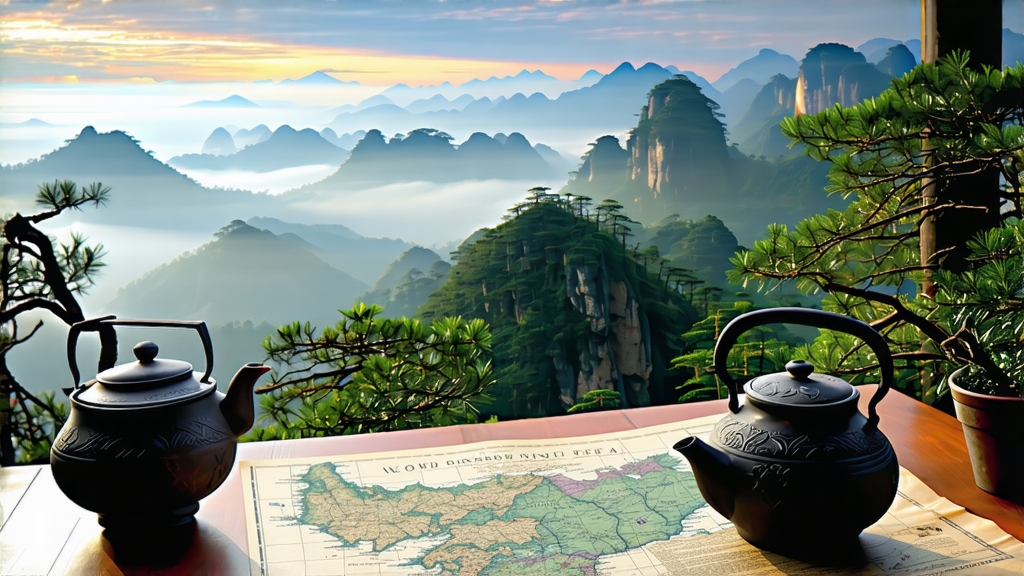
If every tea tells a story, Lapsang Souchong whispers the earliest chapter of black tea. Born in the rugged Wuyi Shan of northern Fujian during the late Ming dynasty, this leaf predates the malty Assams and bright Ceylons that later colonised breakfast tables worldwide. Local lore claims its birth was an accident: Qing soldiers quartered in Tongmu village delayed the usual green-tea drying schedule, forcing farmers to rush the process over open pine fires. The resulting copper-coloured liquor, laced with campfire perfume, travelled down the Min River to the port of Xiamen, where Dutch traders christened it “bohea” and shipped it to Europe alongside porcelain and silk. By the early 1600s Amsterdam cafés were serving “thee of the smoky bohea,” and Catherine of Braganza’s 1662 dowry to Charles II cemented its status as the first Chinese black tea the West ever tasted.
Strictly speaking, only leaf picked within the 600–1,200 m core zone of Tongmu—an area now protected as a UNESCO World Heritage buffer—is entitled to the name Zheng Shan Xiao Zhong (“Original Mountain Small Sort”). Outside this 48 km² enclave, similar techniques yield “wai shan” (outside mountain) styles, yet the difference is as stark as Grand Cru village Burgundy versus generic Bourgogne. Within Tongmu, four micro-cultivars dominate: Cai Cha, a hardy shrub whose young buds yield honeyed notes; Ye Cha, wilder trees that add resinous depth; Jiulongke, prized for its cocoa-like sweetness; and the newly selected Wuyi Qizhong 1, bred for consistency without surrendering terroir. Each cultivar is grafted onto seedling rootstock rather than cloned, preserving genetic diversity in a forest where bamboo, bay laurel and Masson pine share acidic, mineral-rich soils born from weathered tuff and granite.
The craft that converts these leaves into Lapsang Souchong has changed less than the surrounding landscape. Picking begins on the third day after Grain Rain, when two leaves and a bud stand erect like a sparrow’s tongue. The morning’s pluck is carried in shallow bamboo trays to the three-storey wooden loft known as the qing lou. Here, withering is not the gentle indoor wilting of modern black teas but a dramatic sequence of heat, smoke and rest. Pine logs, split from 40-year-old Masson trunks, are stacked into a shallow pit beneath slatted bamboo racks. The fire is kept low, never flaming, so that blue curls of resinous smoke rise for eight hours while the tea masters turn the leaves every twenty minutes. This stage, called song xun (“pine smoking”), imparts the distinctive volatile phenols—guaiacol, syringol, creosol—that later translate into whisky-like warmth. Once the leaves are pliable enough to twist without tearing, they are rolled for 45 minutes in a cast-iron basin lined with hemp cloth, pressure applied by barefoot treading in a dance whose rhythm is dictated by a bamboo clapper. Oxidation follows in cedar-lined boxes; mountain air, cool and humid, slows the process to six hours, half again as long as low-elevation black teas, allowing slower conversion of catechins to theaflavins and a ruby-red rather than brown infusion. Finally the leaves are given a second, gentler smoke for thirty minutes, then baked over charcoal embers until moisture drops to 3 %. The result is a glossy, dark-chocolate strip that crackles when flexed, releasing aromas of pine sap, dried longan and a whisper of lapsang’s signature sweet smoke.
To brew Lapsang Souchong respectfully is to balance its assertive perfume against its underlying complexity. Gongfu style best reveals these layers. Begin with a 120 ml porcelain gaiwan or Yixing zi-sha teapot seasoned only for smoked teas. Heat the vessel with 95 °C water drawn from a bamboo charcoal kettle if you wish to flirt with historical romance. Use 5 g of leaf—about two heaping tablespoons—rinsed for three seconds to awaken the smoke. The first infusion, 10 seconds, yields a liquor the colour of late-autumn maple, bright and translucent; inhale over the gaiwan lid and you’ll catch burnt orange peel and pine honey. The second steep, five seconds longer, introduces cocoa and the faint minerality of Wuyi rock terroir. By